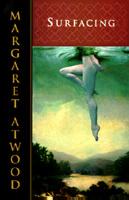

| I. The suspicion of language:
examples:
II. The Use of Tenses: "The novel's present-tense narrative compounds our difficulty in sifting fact from fabrication, as it places the action into the realm of spontaneous discourse, unmediated by time, lacking retrospective contemplation that authenticates what is being said. [See note 10 below] Rather than being a history of the protagonist's discoveries, one that has been evaluated beforehand by a reflective narrator and rendered reliable, Surfacing's narrative is the act of discovery itself--seemingly random, incoherent, and unresolvable--as the narrator engages in a conversation with herself and with the reader. note 10: Even the lengthy segment comprising most of part 2, seemingly given in past tense, is a recapitulation of six days' events, told by the narrator as she sits in the cabin (in the present tense) at the end of those six days, listening to the voices of her companions in the next room. A memory, it records experiences that occurred during her escape from her own time--from her first dive into the lake at the end of part 1, to her entering and then surfacing from her mystical experience in the chapters gapping parts 2 and 3. Source: Jerome H. Rosenberg, "Margaret Atwood", In Twayne's World Authors Series Online. New York: G. K. Hall & Co., 1999 Previously published in print in 1981 by Twayne Publishers. |